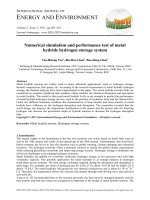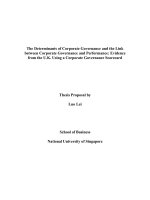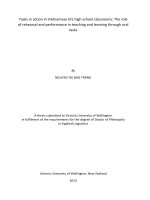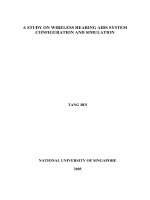Network storage system simulation and performance optimization
Bạn đang xem bản rút gọn của tài liệu. Xem và tải ngay bản đầy đủ của tài liệu tại đây (955.86 KB, 130 trang )
NETWORK STORAGE SYSTEM SIMULATION AND
PERFORMANCE OPTIMIZATION
WANG CHAOYANG
NATIONAL UNIVERSITY OF SINGAPORE
2005
NETWORK STORAGE SYSTEM SIMULATION AND
PERFORMANCE OPTIMIZATION
WANG CHAOYANG
(B. Eng.(Hons), Tianjin University)
A THESIS SUBMITTED
FOR THE DEGREE OF MASTER OF ENGINEERING
DEPARTMENT OF ELECTRONIC AND COMPUTER ENGINEERING
NATIONAL UNIVERSITY OF SINGAPORE
2005
For Rong Zheng
Only your patience and your love and constant support have made
this thesis possible.
i
Acknowledgments
I am sincerely grateful to my supervisors Dr. Zhu Yaolong and Prof. Chong Tow
Chong for giving me the privilege and honor to work with them over the past two
years. Without their constant support, insightful advice, excellent judgment, and, more
importantly, their demand for top-quality research, this thesis would not be possible.
I would also like to thank my ex-colleagues from Data Storage Institute (DSI),
especially the former Storage System Implementation & Application (SSIA) group and
the current Network Storage Technology (NST) division. Without the collaboration
and the associated knowledge exchange with them, this work would again simply
impossible. I would like to delivery my special thanks to Mr. Zhou Feng, Miss Xi
Weiya, Mr. Xiong Hui, Mr. Yan Jie, Mr. So Lihweon and Mr. David Sim for their long
lasting support.
Last, but not least, the support of my parents, parents-in-law and my wife should
be mentioned. I would like at this point to thank my dear wife Rong Zheng, who has
taken many household and family duties off my hands and thus given me the time that
I needed to complete this work. I would also like to thank my parents-in-law, who has
taken care of my daughter during this period.
ii
Contents
Acknowledgments ......................................................................................................... ii
Summary...................................................................................................................... vii
List of Tables ................................................................................................................ ix
List of Figures................................................................................................................ x
1 Introduction................................................................................................................ 1
1.1 Introduction to Data Storage & Storage System ................................... 1
1.2 Main Contributions ............................................................................... 3
1.3 Organization ......................................................................................... 3
2 Background and Related Work................................................................................ 4
2.1 Fibre Channel Overview ....................................................................... 4
2.2 Fibre Channel for Storage .................................................................... 6
2.2.1 Fibre Channel SANs ............................................................................... 6
2.2.2 FC-AL for Storage System ..................................................................... 6
2.3 Storage System Performance Study Methods ..................................... 8
2.3.1 Performance Study by Simulation .......................................................... 9
2.3.2 Theoretical Estimation by Analytical Modeling................................... 11
2.4 Summary .............................................................................................13
3 Command-First Algorithm ..................................................................................... 14
3.1 Analysis of FC-AL Network Storage System .......................................14
3.1.1 FC-AL Based Storage System .............................................................. 15
3.1.2 Storage Controller ................................................................................. 17
3.1.3 Interfacing to the Host Bus Adapter ..................................................... 19
3.1.4 FC HBA Internal Operation.................................................................. 20
3.2 Performance Limitation of Command Queuing Delay .........................22
3.2.1 External I/O Queue ............................................................................... 22
iii
3.2.2 Internal I/O Queue ................................................................................ 23
3.2.3 HBA Internal Queue ............................................................................. 24
3.3 Limitation of Fairness Access Algorithm..............................................24
3.3.1 FC-AL Operation .................................................................................. 24
3.3.2 Arbitration Process and Fairness Access Algorithm............................. 25
3.3.3 Command Delay by Fairness Access Algorithm .................................. 27
3.4 Command-First Algorithm ...................................................................29
3.4.1 Command-First FIFO............................................................................ 30
3.4.2 Command-First Arbitration................................................................... 30
3.4.3 Preemptive Transferring Command...................................................... 31
3.5 Summary .............................................................................................32
4 SANSim and Network Storage System Simulation Modeling ............................. 33
4.1 Introduction .........................................................................................33
4.2 SANSim Overview ...............................................................................33
4.2.1 I/O Workload Module........................................................................... 34
4.2.2 Host Module.......................................................................................... 35
4.2.3 FC Network Module ............................................................................. 36
4.2.3.1 FC Controller Module................................................................. 37
4.2.3.2 FC Switch Module...................................................................... 38
4.2.3.3 FC Port & Communication Module ........................................... 38
4.2.4 Storage Module ..................................................................................... 38
4.3 Simulation Modeling of FC-AL Storage System ..................................39
4.3.1 FC-AL Module...................................................................................... 40
4.3.1.1 Signal Transmission.................................................................... 41
4.3.1.2 Loop Port State Machine ............................................................ 44
4.3.1.3 FC-2 Signaling and Framing ...................................................... 47
4.3.1.4 Alternative Buffer-to-Buffer Flow Control ................................ 49
4.3.2 FC HBA Module................................................................................... 52
4.3.2.1 FCP Operation Protocol.............................................................. 53
4.3.2.2 FCP Initiator Mode ..................................................................... 55
iv
4.3.2.3 FCP Target Mode ....................................................................... 56
4.3.3 HBA Device Driver Module ................................................................. 58
4.3.3.1 FC HBA Initiator Device Driver ................................................ 59
4.3.3.2 Hard Disk Drive Firmware for FC Interface .............................. 60
4.3.4 Model Integration.................................................................................. 60
4.4 Summary .............................................................................................61
5 Calibration and Validation ..................................................................................... 62
5.1 Transmission Calibrations ...................................................................62
5.2 Trends Confirmation ............................................................................65
5.2.1 Performance of One-to-one Configuration ........................................... 66
5.2.2 Effect of Number of Node .................................................................... 70
5.2.3 Effect of Physical Distance ................................................................... 78
5.3 Actual Testing and Simulation Comparison.........................................81
5.3.1 Experimental Environment ................................................................... 81
5.3.2 Result Comparisons .............................................................................. 84
5.4 Summary .............................................................................................84
6 Command-First Algorithm Performance .............................................................. 85
6.1 Overall Method ....................................................................................85
6.2 System Configuration ..........................................................................86
6.2.1 System Overhead Constant ................................................................... 87
6.2.2 Control Variables and Result Collection .............................................. 89
6.3 Result Analysis ....................................................................................91
6.3.1 Based Line System Performance Improvement.................................... 91
6.3.2 Other Performance Factor Analysis...................................................... 98
6.3.2.1 Effect of Read Fraction............................................................... 98
6.3.2.2 Effect of HDD Speed................................................................ 100
6.3.2.3 Effect of Number of HDD ........................................................ 102
6.3.2.4 The Effect of Queue Depth....................................................... 105
6.4 Summary...........................................................................................108
v
7 Conclusion and Future Work ............................................................................... 109
7.1 Conclusion ........................................................................................109
7.2 Future Work ......................................................................................110
Bibliography .............................................................................................................. 112
vi
Summary
Storage systems are generally built by Redundant Array of Independent Disks
(RAID) technology to meet the high performance requirement of enterprise
applications. Besides RAID technology, the interconnection between the Hard Disk
Drives (HDDs) and the RAID controller plays an important role in a high performance
storage system.
Recently, the Fibre Channel Arbitrated Loop (FC-AL) has become the most
common interconnection in the high-end storage systems. The FC-AL topology
provides a high performance serial shared connection between the RAID controller and
the attached HDDs. In such shared connection, all participating devices have to
compete for the access to the loop. When the loop is occupied by data transmission, the
controller has to wait until the loop is free in order to deliver I/O commands to the
HDDs. In such situations, the target HDDs may stay inactive, resulting in
inefficiencies of HDD utilization and finally affecting the whole RAID system
performance.
In order to evaluate the performance of a network storage system, this thesis
develops an FC-AL based network storage system simulation model that can simulate
the FC-AL protocol up to frame level. The simulation model is developed through a
“bottom-up” approach. The FC-AL transmission is modeled in the first place, followed
by the development of L_Port’s other functionalities including the Loop Port State
Machine [LPSM] and the Alternative Buffer-to-Buffer flow control. After that, the
HBA model is provided and the system level integration is performed with additional
consideration of HBA device driver modeling. Lastly, the FC-AL based network
vii
storage system simulation model is calibrated and validated through actual system
experiments. The comparison between actual experiments and simulation shows that
the simulation model can achieves high accuracy as to 3% mismatching for read I/Os.
A new scheduling algorithm for the FC-AL RAID system, the Command-First
Algorithm, is proposed to enable RAID controller to aggressively send I/O commands
to the HDDs with higher priority than I/O data. The Command-First Algorithm is
evaluated using the simulation model. The simulation results show that the
performance improvement contributed by the new algorithm is up to 50% in certain
conditions. It is also shown that there are no negative effects for the Command-First
Algorithm.
viii
List of Tables
Table 5.1
Read Transaction Loop Latency .................................................................70
Table 5.2
Write Transaction Loop Latency ................................................................73
Table 5.3
Experimental System Configuration...........................................................81
Table 6.1
System Overhead Constant.........................................................................88
Table 6.2
Initiator HBA Overhead & Control Constant.............................................88
Table 6.3
FCP Target Overhead & Control Constant.................................................89
Table 6.4
Configuration Variables..............................................................................90
Table 6.5
CMDF Data Throughput Relative Improvement........................................96
ix
List of Figures
Figure 2.1 Fibre Channel Logical Layer ........................................................................5
Figure 2.2 Fibre Channel Arbitrated Loop Topology ....................................................8
Figure 2.3 Queuing Network for Storage System........................................................12
Figure 3.1 Storage System for SAN and NAS.............................................................14
Figure 3.2 FC-AL Storage System Architecture..........................................................16
Figure 3.3 Storage Controller Internal Architecture ....................................................17
Figure 3.4 RAID Controller Internal I/O Process Flow ...............................................18
Figure 3.5 Fibre Channel HBA Operation Model........................................................20
Figure 3.6 Command Delay with Fairness Access Algorithm.....................................27
Figure 3.7 Command Delay Timing Model .................................................................28
Figure 3.8 Command Frame Priority Queuing ............................................................29
Figure 4.1 SANSim Internal Structure.........................................................................34
Figure 4.2 Fibre Channel Network Modeling in SANSim ..........................................37
Figure 4.3 FC-AL Simulation Model Structure ...........................................................40
Figure 4.4 Signal Transmission Model ........................................................................42
Figure 4.5 “Edge-Change” Simulation Technique.......................................................43
Figure 4.6 Loop Port State Machine ............................................................................45
Figure 4.7 Alternative Buffer-To-Buffer Flow Control...............................................50
Figure 4.8 State Transition Delay for Alternative BB Credit ......................................51
Figure 4.9 FC HBA Model Structure...........................................................................52
Figure 4.10 FCP I/O Operation Protocol .......................................................................53
Figure 4.11 FCP Initiator Mode HBA Model Structure ................................................55
Figure 4.12 FCP Target Mode HBA Model Structure...................................................57
Figure 4.13 FC HBA Device Driver Model...................................................................59
Figure 4.14 HDD Firmware Function Model ................................................................60
Figure 4.15 System Level Integration ............................................................................61
Figure 5.1 Finisar GTX-P1000 Analyzer Logical Configuration ................................62
Figure 5.2 Fibre Channel Analyzer Trace....................................................................63
Figure 5.3 Simulative L_Port Event Trace ..................................................................64
Figure 5.4 Close-System I/O Workload.......................................................................65
Figure 5.5 FC-AL Throughputs with Two Nodes Configuration ................................68
Figure 5.6 Queue Depth Effect with Two Nodes Configuration .................................69
Figure 5.7 Effect of Number of Nodes.........................................................................72
x
Figure 5.8 Small I/O Read/Write Comparisons for Node Number Effect ...................74
Figure 5.9 Sufficient Buffering to Improve Performance ............................................76
Figure 5.10 Effect of Number of Node with Optimal Buffering ...................................78
Figure 5.11 Effect of Physical Distance.........................................................................79
Figure 5.12 Read Experiments Comparisons.................................................................83
Figure 5.13 Write Experiments Comparisons................................................................83
Figure 5.14 Queue Depth Effect Experiment Comparisons...........................................83
Figure 6.1 Performance Evaluation Method for CMDF ..............................................85
Figure 6.2 System Configurations................................................................................87
Figure 6.3 Based Line Storage System Data Throughput Comparison .......................92
Figure 6.4 Based Line Storage System I/O Throughput Comparison .........................93
Figure 6.5 Based Line Storage System Average Response Time ..............................94
Figure 6.6 Effect of Read Fraction for CMDF.............................................................99
Figure 6.7 Effect of HDD Speed for CMDF..............................................................101
Figure 6.8 Effect of Number of HDD for CMDF ......................................................103
Figure 6.9 Effect of Queue Depth Per HDD for CMDF ............................................106
xi
Chapter 1
Introduction
1.1 Introduction to Data Storage & Storage System
Along with the rapid development of IT technology, the demand for higher
performance and bigger capacity on data storage has been constantly increasing in the
past decades. Multimedia technology enables people to store videos in the form of
hundreds of mega bytes of digital data and to playback anytime. Large databases are
widely implemented for decision-making or process controlling, which requires data to
be up-to-dated and available constantly. A large number of mission-critical
applications demand for high performance for data storage.
The magnetic hard disk drives (HDDs) are used as the primary storage device for a
wide range of applications. Since it was invented half-century ago by IBM, the HDDs
have undergone continuous technological evolutions, yielding larger-capacity,
higher-performance, smaller-form-factor and lower-cost. The areal density of HDD has
increased about 35 million times since it was first introduced [6]. The recent CGR
(compound growth rate) of the areal density is about 100 percent, or doubling every
year, which has broken through the Moore’s law of doubling capacity every eighteen
months for the semiconductor growing. In year 2005, the HDDs with capacity of
hundreds gigabytes are commonly available.
Even with the areal density positively advancement, the total HDD shipment
surprisingly does not decrease. The two famous market research companies,
TrendFOCUS and IDC, both forecasted over 20 percent grow of total units of HDD
1
shipment from about 305 million units in year 2004 to about 378 million units in year
2005. The essential reason for demanding more HDDs is that the HDD access
performance increases much slowly comparing to the capacity improvement. The CGR
slopes of the mechanical seeking time and the rotational latency of HDD has only
about 25 percent [5]. The individual HDD is therefore not able to meet the enterprise’s
performance demand.
To fill the performance gap and to optimize the cost and reliability, the storage
system that can provide aggregated performance of multiple HDDs has long been one
of the corner stones for enterprise data storage. The RAID technology enables the
storage system to serve I/O request in parallel through striping user data across
multiple HDDs, and to enhance system reliability by parity protection preventing data
lost in the event of individual HDD failure.
By introducing large memory cache, the
storage system can accelerate the I/O requests without reading data from the HDDs.
Many other technologies have been developed to optimize the performance. One
important technology is the interconnection between the HDDs and the RAID
controller, which may limit the storage system performance.
A storage system usually consists of one or more separate control units and
multiple HDDs. The control units access to the HDDs through an interconnection. In
ideal situations, each HDD shall dedicatedly connect to the storage controller by means
of unblocked switching network for high parallelism, but it would require much higher
cost. The balance between the parallel performance and the cost is the crucial factor for
success. A shared connection is therefore used as an alternative to provide the
sufficient bandwidth. After the traditional SCSI bus architecture, the Fibre Channel
Arbitrated Loop (FC-AL) has become the most frequently used interconnection for
high-end network storage systems.
2
1.2 Main Contributions
This thesis provides four major contributions to the studies of FC-AL based
high-end storage systems as following:
z
An effective and detailed simulation model is built to support frame and
transmission word level simulation;
z
Hardware trace level calibration and actual system experiment comparison are
performed for simulation model validation;
z
A new schedule algorithm is proposed to aggressively delivery I/O commands
to optimize I/O performance;
z
The simulation results show that the performance improvement contributed by
the new algorithm is up to 50%.
1.3 Organization
The thesis is organized as follows. Chapter 2 presents the basic background of
storage systems and investigates the current status of research in FC-AL network
storage systems. Chapter 3 conducts operational analysis on FC-AL based storage
systems and presents the Command-First Algorithm. In order to effectively evaluate
the performance of a network storage system, a detail simulation model for FC-AL
storage system is presented in Chapter 4. The simulation model is calibrated and
validated in Chapter 5. Chapter 6 presents the I/O performance evaluation of the
Command-First Algorithm by simulation. Finally, Chapter 7 summarizes the research
and discusses the future research work.
3
Chapter 2
Background and Related Work
2.1 Fibre Channel Overview
Fibre Channel (FC) is a high speed serial interface defined by the ANSI
(American National Standard Institute) as an open industry standard. There are more
than 20 published standards or drafts for different aspects of FC [13]. More recent
development of the FC standards can be found in the FC Project of the T11 Technical
Committee [12].
FC is generally characterized by high speed, long distance, and high scalability
for storage. It provides a general transport network platform for Upper Level Protocols
(ULP) such as SCSI (Small Computer Systems Interface [38]). The SCSI mapping over
the FC is defined in FCP (Fibre Channel Protocol for SCSI) [11].
FC can be logically divided into five logical layers, numbered from bottom to
top as FC-0 to FC-4, as shown in Figure 2.1. Similar to layers in the OSI’s model, each
FC logical layer performs a certain set of functionalities interfacing to nearby layers.
The FC-0 layer defines the physical interface for the FC network for the specification
of transmitter, receiver and the signal propagation media, which includes the fiber
optic cable and the electronic copper cable. The FC-1 layer performs 8bit/10bit coding
and decoding and error control.
Sitting on top of the FC-1 layer, the FC-2 organizes
information into a set of frames, sequences, and exchanges and defines other signaling
protocols such as flow control. The FC-3 layer provides additional common services
such as multiple link trunking, multicasting and other services.
The FC-4 layer
4
Figure 2.1 Fibre Channel Logical Layer
facilitates the mapping to upper-level protocols such as SCSI, IP, and others.
Additionally, there is a Fibre Channel Arbitrated Loop (FC-AL) [9] protocol between
the FC-1 and FC-2 layers labeled as FC-1.5 in Figure 2.1, which allows the attachment
of multiple devices to a common loop without switches. The FC-0, FC-1 and FC-2 layer
are collectively defined in FC-PH [10].
Three basic classes of service are defined in FC standard: Dedicated
connection (Class 1), Multiplex (Class 2) and Datagram (Class 3). Class 1 provides
circuit switch, dedicated bandwidth connection. The connection must be established
before data can be transferred. Once the connection is established, the full bandwidth is
guaranteed until one party releases the connection. Class 2 is a connectionless service.
Frames are independently routed to the destination port by the Fabric, if present. An
end-to-end acknowledgement of frame reception is required for this class. Class 3 is
similar to Class 2, except that no acknowledgement of receipt is given. In Class 3, the
fabric, if present, does not guarantee the successful delivery of frame and it may discard
frames without notification under high-traffic or error conditions; any error recovery or
notification is done at the ULP level. Without acknowledgement, the Class 3 service
5
provides the quickest transmission and thus it is the most frequently used in various
applications including the SCSI application for storage systems.
2.2 Fibre Channel for Storage
2.2.1 Fibre Channel SANs
A Storage Area Network (SAN) is a dedicated, centrally managed, secured
information infrastructure, providing any-to-any interconnection of servers and storage
systems. SANs are currently the preferred solution for fulfilling a wide range of critical
data storage demands for enterprises [30].
The FC is presently the dominant protocol used in SAN to provide the high
performance data connection. The perfect marriage of the two technologies makes the
great success of both FC and SAN, although other emerging alternatives such as iSCSI
protocol are now developed as the compliments to FC for low cost and other
considerations. Many SAN books actually exclusively discussed the Fibre Channel
technologies adoption, such as [27], [28] and [29].
Fibre Channel supports three types of connection topologies, Fabric, Point to Point
and Arbitration Loop. Since the FC-AL provides a cost effective shared connection
among multiple devices without using expensive switches, it has become a popular
means of interconnecting the storage controllers to the attached HDDs.
2.2.2 FC-AL for Storage System
Since IBM introduced the world’s first storage device in 1945, the storage system
has gone through the same period of evolution as the HDD did [5]. Initially, a storage
subsystem was just a HDD. Over time, more hardware and software functions were
added to the storage system to achieve higher performance, better reliability and lower
6
cost [6]. The RAID technologies were first proposed in 1980s in [7] to provide a
means of parallelism between multiple HDDs to improve the aggregate I/O
performance and at the same time to extend the whole system reliability through
redundant parity. Since then, various new technologies had been developed to enhance
and optimize the I/O performance of the RAID storage system [8], and the storage
system has become a cornerstone of the entire data storage industry.
Among other factors in a storage system, the interconnection between the storage
controllers and the HDDs is important for the high I/O performance and reliability.
Alternative to the traditional parallel SCSI bus architecture, the FC-AL provides a high
performance reliable common sharing serial interconnection for multiple devices.
Although it is shared topology, the loop has the channel property with which one
device can establish a dedicated communication channel with anther device on the
loop.
The FC-AL topology supports up to 127 devices within a single loop. With 1 G
link rate (precisely 1.0625 GHz clock), the loop provides a common 100 MB/s
bandwidth information transport vehicle for all devices. With support of full duplex, one
may transmit or receive data frames simultaneously and thus achieves double the
bandwidth. The latest development of 4 G link rate further increases the bandwidth to
400 MB/s and 800 MB/s for half duplex and full duplex respectively. With optical
cables, the physical distance of a loop may extend to 10 kilometers. Additionally,
inherited from the common FC feature, the loop provides higher reliability of
communication. All the above mentioned advantages make the FC-AL connection far
exceed the traditional parallel ATA and SCSI interface. Figure 2.2 shows such a storage
system deploying the FC-AL topology with one initiator (controller node) and multiple
HDDs.
7
Figure 2.2 Fibre Channel Arbitrated Loop Topology
Nowadays, a large number of Fibre Channel HDDs are shipped every month from
every major HDD vendor. These HDDs are mostly (if not all) used as member HDDs in
a storage system. They are most frequently connected through FC-AL loops. It is not
surprising, then, to see a large number of academic publications on FC-AL related
storage system architecture. In the work of Shenze Che and Manu Thapar [22], the
performance of the Video-on-Demand server using FC-AL was compared to traditional
SCSI interface. The reported performance improvement was 50% better. In [23], the
authors provided a software architecture enabling FC-AL based RAID system in a
real-time operating system. The potential of low-cost switching architecture for
extending FC-AL scalability was studied in [24] and a concreted implementation and
study of FC-AL architecture in a real application were presented in [25].
2.3 Storage System Performance Study Methods
Many research works have been conducted on storage technology, storage
networking, and storage subsystem. All those works eventually aim to achieve better
8
performance in terms of higher throughput, shorter latency and wider bandwidth. The
performance analysis becomes the key to predict, assess, evaluate and explain the
system’s characteristics. There are generally three approaches to conduct performance
analysis for computer system: analytical modeling, physical measurement and
simulation modeling [41].
A survey on the success stories of using these approaches
to study the storage system performance was provided in [14].
The alternative to the analytical modeling and physical measurement is the
simulation modeling, in which a computer program implements a simplified
representation of the behavior of the components of the storage system, and then a
synthetic or actual workload is applied to the simulation program, so that the
performance of the simulated components and system can be measured. Simulation
can provide a view of the system behavior at any level of detail, provided that enough
modeling manpower is available. Trace-driven simulation is an approach that controls
a simulation model by feeding in a trace, a sequence of specific events at specific time
intervals. The trace is typically obtained by collecting measurements from an actual
running system.
2.3.1 Performance Study by Simulation
The physical measurement performs testing and collects measurements performance
data of a running system. By analyzing the relationship between the performance
characteristics, the workload characteristic, and the storage system components,
researchers are able to identify problems and give make decisions on purchasing and/or
configuration for storage system. In [26], Thomas M. Ruwart had conducted
experimental testing on a real system for different combinations of loop distance and
hard disk number.
9
The real system experimental tests however are often subjected to the given
implementations of vendor specific loop devices, such as the number of the frame buffer
and FC-AL scheduling. Experimental modifications on such hardware are often not
feasible for academic research. Meanwhile, real system experiments usually involve a
very high cost. To conduct a study like [26] will require expensive infrastructure such as
kilometers of fibre optic cables and other equipments.
On the contract, the simulation does not require the presence of an actual system. In
[20], John R. Heath and Peter J. Yakutis implemented their simulation models and
analyzed the performance of FC-AL based storage systems. They discussed the FC-AL
protocol in detail but they did not provide the calibration and validation detail of the
simulation model. Similarly, in [21], David H.C.DU and Tai-Sheng Chang et al.
compared SSA (Serial Storage Architecture) [39] and FC-AL interfaces for disks by
simulation, but the detail modeling method of the FC-AL was not given. Xavier [15] and
Petra [16] also developed simulation model for FC but they modeled more on Fabric
SAN. Some published simulation tools for other storage system’s components can also
be found. The DiskSim[17] and Pantheon[19] are the two well known HDD simulators.
The former had been used in many HDD performance researches such as the
time-critical I/O in [18] and [35], and the HDD schedule optimization in [31] and [32]. A
detail simulation model of a system bus (PCI bus) can be found in [36].
Although simulation modeling has been proven to be an effective approach for
system performance study and new algorithm evaluation, there are some limitations on
current available simulation tools. Firstly, there are few simulation tools that can support
detailed enough simulation studies especially when systems under study become more
complicated. Secondly, a simulation model is an abstracted presentation of an actual
system. Some system reactions are assumed to have minimum impact to the overall
10
performance and others are modeled as constant overheads (or random variables with
stochastic distribution). The simulation model must therefore be calibrated with actual
system measurements for these overhead constants and further be validated by
examining the simulation results to agree with experimental measurement, before it can
be used for performance prediction in extended situations. Although some of the above
mentioned FC-AL studies were done through simulation, the calibration and validation
of these simulation models were seldom given. It is therefore worthwhile to develop a
new simulation tool that can simulate the detail behavior of the FC-AL network storage
system.
2.3.2 Theoretical Estimation by Analytical Modeling
The analytical modeling makes attempts to predict storage system performance as a
function of parameters of the workload, storage components, and system configuration
by writing mathematical equation. The work in [34] severed as an example of this
approach. The analytic analysis can provide insight into the steady-state performance
and give theoretical performance bounds of the storage system. It usually needs queuing
theory and Markovian analysis, which requires extensive knowledge of probability
theory. In addition, analytical modeling requires skill at approximating the storage
system with simplified mathematical models.
In most analytical works, the internal components of a storage system are modeled
as various service centers that can process requests at a certain service rate. The arrival
requests, i.e. the service demands, are assumed to follow certain distribution (mostly in
Poison Arrival that describes the independent arrival) and the service rate of the
service centers are of some stochastic pattern (such as Poison Process) as well.
Although the analytical modeling may lack detail when compared to the real system
11
physical measurement and the simulation, it gives some theoretical insight of the
process and effectively predicts the performance bounds of the given storage system.
In [1], Dr. Zhu et al presented their analytical work on SANs for the purpose of
identifying performance bottlenecks. A queuing network model for storage system and
storage network was established from the host systems, along with the FC fabric
network, to the disk array internal components. Six tiers of services centers were
defined to model the I/O processing activities, namely Hosts, FC-SW network, Disk
Array Controller and Cache, FC-AL Network, Disk Controller and Cache and HDA
Center, as shown in Figure 2.3 adopted from the paper. The Fork/Join model was used
to analyze the performance of the disk array. The response time and utilization of each
component as well as the overall system were derived and analyzed based on the
queuing network theory.
With regards to the performance of FC-AL Network, the authors highlighted that
the “access fairness” algorithm may be a potential problem for disk array controllers to
obtain the optimal overall performance.
Figure 2.3 Queuing Network for Storage System Adopted From [1]
12



![silva and leal - 2005 - corporate governance index, firm valuation and performance in brazil [bcgi]](https://media.store123doc.com/images/document/2015_01/02/medium_hey1420194808.jpg)
![silva and leal - 2005 - corporate governance index, firm valuation and performance in brazil [bcgi]](https://media.store123doc.com/images/document/2015_01/06/medium_gjz1420548433.jpg)




